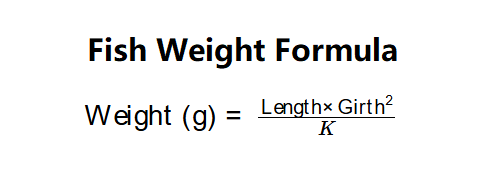1. What is a Fish Weight Calculator?
Definition: This calculator estimates the weight of a fish based on its length, girth (if provided), and species, using a standard formula adjusted for different fish types.
Purpose: It helps anglers, researchers, and fishery managers estimate fish weight without a scale, useful for catch-and-release practices and data collection.
2. How Does the Calculator Work?
The calculator uses the following formula:
\( \text{Weight (g)} = \frac{\text{Length} \times \text{Girth}^2}{K} \)
Where:
- Length: The length of the fish (in cm, m, inch, or feet, converted to cm).
- Girth: The girth of the fish (in cm, m, inch, or feet, converted to cm; if not provided, estimated as \( \text{Girth} = \text{Length} \times 0.58 \)).
- K: A species-specific constant.
Steps:
- Enter the Length and select its unit (cm, m, inch, feet).
- Optionally, check "I know both length and girth," enter the Girth, and select its unit.
- Select the Species.
- Validate inputs to ensure they are positive.
- Compute the weight in grams using the formula, then convert to the selected unit (g, dag, kg, lb, oz) in the result section.
- Display the result to 6 decimal places with the unit dropdown next to it.
3. Importance of Fish Weight Calculation
Calculating fish weight is crucial for:
- Catch-and-Release: Allows anglers to estimate weight without harming the fish.
- Fishery Management: Helps in monitoring fish populations and health.
- Recreational Fishing: Enhances the fishing experience by providing estimated weights for records or competitions.
4. Using the Calculator
Example 1: A Trout with a length of 0.5 m, girth not provided:
- Length: 0.5 m = 50 cm
- Girth: \( 50 \times 0.58 = 29 \, \text{cm} \)
- Species: Herring, Shad, Trout (\( K = 32.513 \))
- Weight: \( \frac{50 \times 29^2}{32.513} = \frac{50 \times 841}{32.513} \approx 1292.831 \, \text{g} \)
- Result in lb: \( 1292.831 / 453.592 \approx 2.851 \, \text{lb} \)
Example 2: A Bass with a length of 16 inches and girth of 10 inches:
- Length: 16 inches = \( 16 \times 2.54 = 40.64 \, \text{cm} \)
- Girth: 10 inches = \( 10 \times 2.54 = 25.4 \, \text{cm} \)
- Species: Bass, Striper (\( K = 28.9 \))
- Weight: \( \frac{40.64 \times 25.4^2}{28.9} \approx 907.465 \, \text{g} \)
- Result in oz: \( 907.465 / 28.3495 \approx 32.015 \, \text{oz} \)
5. Frequently Asked Questions (FAQ)
Q: Why is girth estimated if not provided?
A: Girth is estimated as \( \text{Length} \times 0.58 \) to provide a reasonable approximation based on typical fish proportions.
Q: What units does the calculator support?
A: Length and girth can be in cm, m, inch, or feet. Weight can be in g, dag, kg, lb, or oz, with the unit selectable next to the result.
Q: How accurate is the estimated weight?
A: The estimate is based on a standard formula and may vary depending on the fish’s actual shape and condition.
 Home
Home
 Back
Back
